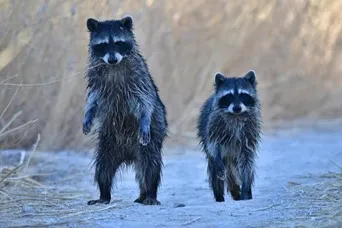The Raccoon

Raccoons (Procyon lotor) are well-known for their black masks, gray color, and tails with six white and six black rings and a black tip. These intelligent, resourceful, and adaptable nocturnal residents of Clark County Wetlands Park are also found everywhere in North America that has the water they require. Almost every state has them. There are over twenty subspecies, including three in the state of Nevada!
Raccoons are not often seen abroad in daylight. Usually, they are true creatures of the night, foraging under cover of darkness. Daytime finds them curled up in their dens, usually holes in trees or rock crevices. But, because they live easily near people, they may move into mine shafts, abandoned buildings, and even sheds, garages, and drainpipes.
Raccoons are true omnivores, feeding on whatever is available. They dine on wild plant foods from fruits and berries to nuts, including wild grapes and acorns. They help themselves to cultivated peaches, plums, watermelons, and corn. They hunt the edges of ponds and streams for crayfish, snails, frogs and fish, and search drier parts of their territories for insects, rodents, and bird eggs. Those living near humans scour trash cans, pet dishes, and roadkill for edibles.
When foraging or traveling undisturbed, raccoons walk flat-footed with a gait that has been described as a bear-like “shuffle,” seemingly in no hurry to get anywhere. If pursued, however, they can sprint at fifteen miles an hour. They are agile, quick climbers who think nothing of climbing thirty to forty feet, and they swim just as well as they climb. If cornered, they fight fiercely, and have been known to drive off coyotes, owls, and even dogs twice their size.
It’s fun to check the ground for raccoon tracks as you walk Wetlands Park trails. Each foot has five slender toes with claws. The front feet look like little hands, and the back feet, with their long naked heels, resemble the footprints of a small child. Follow the trail if you can! You may also find a pile of crayfish shells and claws at the water’s edge, left over from last night’s raccoon dinner!
Please enjoy these YouTube videos!
Raccoon catching crayfish
Raccoon swimming
Three raccoons swimming
– By Chris Leavitt, President; photo by Philip Martini
